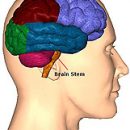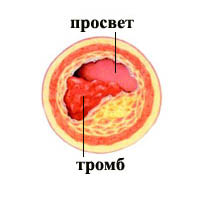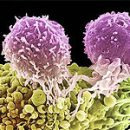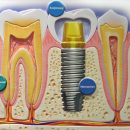How is the operation of the Aorto-femoral shunting, which complications can be and how to behave after the operation - read in this article.
Content
Shunting or artery prosthetics — Start of blood on an artificial vessel bypassing the obstacle.
Aorto High Shunting
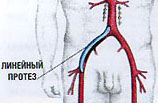 With one-sided lesion of the arteries of the pelvis (iliac arteries), the synthetic prosthesis is sewn higher and below the blockage and blood goes around.
With one-sided lesion of the arteries of the pelvis (iliac arteries), the synthetic prosthesis is sewn higher and below the blockage and blood goes around.
This prosthesis is located either parallel to the clogged artery (shunting), or instead of it (prosthetics).
For access to vessels, the median or side cut of the belly and another incision — In the groin, here the prosthesis is sewn to the femoral arteries.
Aorto-femoral bifurcation shunting (ABBSH)
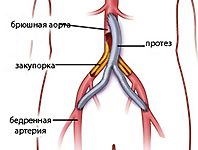 If both iliac artery is closed, the so-called bifurcation prosthesis is sewn. Patients also call him «trousers».
If both iliac artery is closed, the so-called bifurcation prosthesis is sewn. Patients also call him «trousers».
For this, there is also a cut in the middle line of the abdomen, sometimes lateral.
Additionally, two more cuts are required in groin, on both sides to sew a prosthesis to the thigh vessels.
The aortic prostheses do not turn back, do not burst and rightly serve throughout the life of the patient.
Anesthesia during operation Aorto-femoral shunting
The operation is most often performed under epidural anesthesia (installation of a thin catheter in the lower back in the area of spinal cord roots) and general anesthesia (anesthesia). Applying epidural anesthesia allows several times to reduce dosages of administered drugs for general anesthesia.
Possible complications of the operation of the Aorto-femoral shunting
Despite the high care of the operation, no one is insured against complications.
Thrombosis (blockage) Shunt. Shunt thrombosis is possible both during surgery and after enough long time after it. Most often this is due to the poor state of the vessels of the leg. When thromboosis, blood supply to the leg decreases, sometimes sharply. In such cases, re-operation is required. If it is impossible for re-operations, drug therapy is limited (dropper). Unfortunately, in extremely rare cases, the legs cannot be saved and amputation is performed.
Bleeding from vessels in the zone of operation, which can be stopped only by re-operation. In cases of massive blood loss, blood transfusion or its components may be required.
Heart complications. Operation is a serious test for the heart. Sometimes during surgery, it does not cope with an increased load, which requires a patient in the intensive care unit within a few days. Most often it happens with a pronounced lesion of the heart vessels. However, even transferred myocardial infarction is not a contraindication to the operation.
Renal failure (extremely rare, usually with already existing chronic renal failure). In such cases, it may be necessary to connect an artificial kidney apparatus (hemodialysis).
Limphorye. In the area of the skin cut in the groin, in addition to the arteries and veins, there are also many smallest lymphatic vessels carrying the interstitial fluid into large veins. If they are damaged, lymphs may occur — Limphory, and sometimes for a long time (up to several weeks). Limphory increases the risk of infections of wound or prostheses. It is usually amenable to local treatment.
Swelling of the operated leg. It may arise in the first few days after the operation and maintain quite a long time (several weeks), which is associated with an increase in blood flow to the foot after the operation, while the outflow is preserved at the preoperative level.
Disturbing Skin Sensitivity. In the area of the skin cut on the leg passes many skin nerves. Often they are damaged, which leads to a short-term or long (rarely) lack of sensitivity in the zone of skin cuts, which leads to a fairly long sensation of numbness on the inner surface of the upper third of the thigh from the operation side.
Range navalization, the discrepancy of the seams in the wound region arise rarely, but their occurrence delays the process of recovery, and a rough scar may form.
Outcome of the operation of aorto-femoral shunting
In most cases, the operation turns out to be successful and allows not only to keep the leg, but also significantly improve the quality of life of the patient.
Behavior after surgery
To achieve an excellent treatment result, you need your participation and confidence in the success of operations!
Remember that even after surgery you need to continue to treat the main disease (atherosclerosis) and prevent its progression. Some recommendations that need to be followed:
- Refuse smoking.
- For life to take the so-called disaggregative drugs (Aspirin, Trombo-AC, Plaviks). Thus, your blood is diluted and the risk of blood clots in vessels and prostheses is reduced.
- Reduce blood pressure, that is, treat the arterial hypertension.
- Reduce blood cholesterol.
- Fight overweight.
- Fight hypodynailia. Do not be afraid of physical exertion, the implanted prosthesis does not come off! Need daily walking, at least 1 hour per day.

